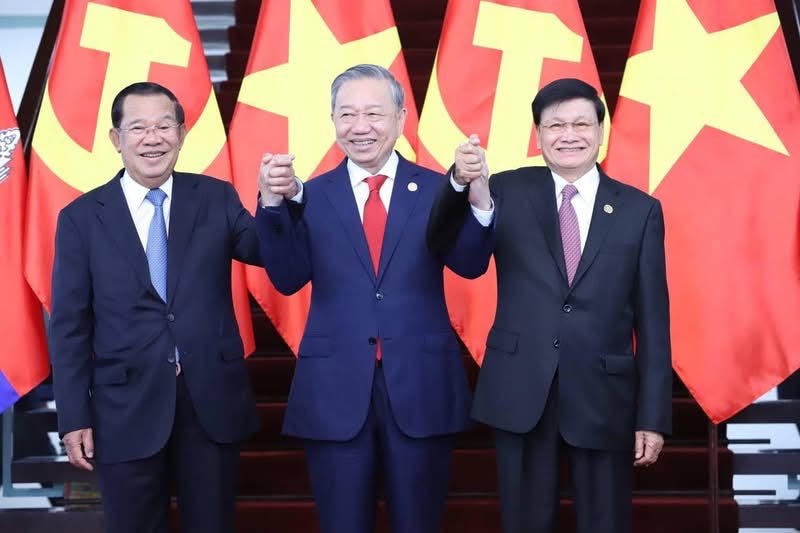New Trilateral Meeting Headlines 2025 Mekong and CLV Dynamics
Plus new flashpoint advisory; foreign security law fallout; intercontinental supply chain pact; DeepSeek contagion; coming space forays and much, much more.
Greetings to new readers and welcome all to the latest edition of the weekly ASEAN Wonk BulletBrief! If you haven’t already, you can upgrade to a paid subscription for $5 a month/$50 a year below to receive full posts by inserting your email address and then selecting an annual or monthly option. You can visit this page for more on pricing for institutions, groups as well as discounts. For current paid subscribers, please make sure you’re hitting the “view entire message” prompt if it comes up at the end of a post to see the full version.
For this iteration of ASEAN Wonk BulletBrief, we are looking at:
Assessing the geopolitical and geoeconomic significance of a new trilateral meeting in Southeast Asia and its subregional and regional impacts;
Mapping of regional developments including a new flashpoint advisory; a coming defense pact and maritime boundary management;
Charting evolving geopolitical, geoeconomic and security trends such as foreign security law fallout; intercontinental supply chain pact and DeepSeek contagion regional hype;
Tracking and analysis of industry developments and quantitative indicators including coming space forays; new energy blocks; shifting power metrics and more;
And much more!
This Week’s WonkCount: 2,346 words (~11 minutes)
New Flashpoint Advisory; Coming Defense Pact & More

Polarity Polarization; Cyber Surge & Subregional Contestation
“The widespread preference for bilateral deals rather than inclusive multilateral cooperation…suggests that the type of cooperation needed to address the world’s most pressing problems is increasingly hard to obtain,” per responses from this year’s Munich Security Index released as part of just-concluded Munich Security Conference deliberations. The report includes responses on a series of questions including the state of world order. Among other findings, it notes that respondents were split on whether the world order is currently characterized as U.S.-dominated (about one third); U.S.-China bipolarity (about one third) or multipolar with powers beyond the US and China having a strong and independent influence (about one quarter) (link).
Select Country Respondent Views on Question: “In The Future, My Country Should Prioritize Bilateral Relations….Than Invest in Multilateral Initiatives and International Organizations”
“Those numbers have drastically increased in the past 10 years,” including in Southeast Asia, argues a new report on state-sponsored economic cyber espionage incidents released by the Australian Strategic Policy Institute. The report notes that there has been a tripling of cyber incidents since 2015, including a percentage increase of more than four times in terms of incidents affecting and targeting private sector entities in Southeast Asia (link).
Number Of Reported Incidents Of State-Sponsored Cyber Operations Between 2009 And 2022
“Its outreach to the US and China for support is more about publicity than anything else, but…it is not impossible that at some point China could see the Sultan as a way of needling the Marcos government,” observes a new report by the Institute for Policy Analysis of Conflict that examines the so-called Mindanao-Sulu Unification Movement within the broader issue of the Philippines’ postponement of elections in Muslim Mindanao until October 2025 and the exclusion of Sulu in a Supreme Court decision. Noting the impact of evolving dynamics for Philippine foreign policy and domestic politics, the report urges the Marcos administration to work towards a solution “to ensure that disgruntlement does not lead to a new phase of the conflict.” (link)
New Trilateral Meeting Headlines 2025 Mekong and CLV Dynamics
What’s Behind It
Southeast Asia witnessed the holding of a new trilateral meeting format this past week1. In what was messaged by officials as a “new format” trilateral, party leaders and premiers of Cambodia, Laos and Vietnam met in Ho Chi Minh City where they agreed on several areas of collaboration2. This came ahead of several other upcoming developments placing the emphasis on evolving mainland Southeast Asia dynamics. As we previewed in our latest exclusive ASEAN Wonk Podcast episode, Vietnam is about to host a follow-up to its newly-launched ASEAN Future Forum featuring key leaders including ASEAN chair Anwar Ibrahim and Secretary General Kao Kim Hourn3. Meanwhile, Thailand is about to kick off the latest iteration of its Cobra Gold exercises with the United States, which remains the largest joint and combined exercises of its kind in the Indo-Pacific4.
Select Key Recent Subregional Developments in Mainland Southeast Asia Amid Trilateral Meets
The meetings mark an ongoing recalibration in minilateral interactions in mainland Southeast Asia. All three countries have been looking at what has been characterized variously as forms of “new approaches” to enhance trilateral cooperation in 2025 alongside personnel shifts in all three countries and evolving cross-border dynamics such as the regional reverberations of China’s elevated focus on high-profile scam operation repatriations5. Occasional developments surfacing in the public domain such as Cambodia’s withdrawal from a trilateral development triangle area have also highlighted the quiet recalibration process underway in this regard, with periodic irritants including recent Thai-Cambodia border tensions also intervening along the way6.
Why It Matters
The engagements also shed light on key details in the evolving agenda with bilateral, regional and global components (see originally generated ASEAN Wonk table below on notable datapoints and additional specifics. Paying subscribers can read on for more on what to expect and future implications in the rest of the “Why It Matters” and “Where It’s Headed” sections, along with paid-only sections of the newsletter as usual).











